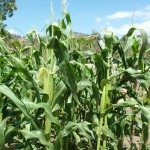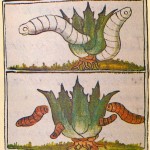On this page we have assembled resources in preparation for our excursion to visit the Ethnobotanical Garden in Oaxaca. Please also see the special pages we have created for potential curricular units relating to various ethnobiology topics.
You might begin with this artistic footage of stills shot in the garden and presented with classical music (less than 4 minutes). And, here is a short introductory video (in Spanish; less than 2 minutes) about the garden. (It now has even more plants and species than were tallied at that point.)
The Jardín Etnobotánico of Oaxaca has its own website, showing the entryway (at the corner of Reforma and Constitución), a map, scenes around the garden, the garden library, some of the work involved in creating the garden, and some of the plantings. The setting is beautiful and the thought and planning that have gone into the garden’s design are impressive. The famous Mexican artist Francisco Toledo played a major role in helping bring this garden to fruition. It covers 2.3 hectares of land adjoining the Santo Domingo Cultural Center. It is home now to thousands of plants, hundreds of plant species native to the state of Oaxaca, and some have been rescued from certain death at construction sites. Currently under development within the grounds of the garden is a hothouse for native varieties of orchids.
Guided tours require that we stay on the designated paths and not take anything home with us except photos. The two-hour tour is jam-packed with information about the origin of the plants and their ethnic uses and meaning through history. The time will pass very quickly. In both 2010 and 2011 we were not allowed into the garden because we had planned an afternoon visit and it rained. So, in 2014 we are hoping to get into the garden on a Saturday morning. You might want a hat, sunscreen, a bottle of water, a camera, and a notebook for taking down some of the information.
Some of the many plants and trees you will see, in the order, more or less, as viewed in the tour, include (let’s try to improve on these notes and add photographs):
- arbol del tule (a cypress), a ficus (higuera in Spanish, and amatl in Nahuatl);
- willow (source for aspirin);
- walnut tree (useful for a dark brown dye from the husk of the nut);
- chirimoya (custard apple);
- horsetail, a very primitive weed that, when boiled, can be a remedy for kidney stones. It can also be useful for scrubbing;
- “touch me not,” a mimosa plant, also called “vergonzosa,” provides a remedy for kidney stones (when boiled and drunk as tea);
- elderberry flowers, providing a remedy for a sore throat and for making a liqueur called sambuca;
- guava, the leaves, when boiled, provide a remedy for diarrhea;
- sage (there are 300 species in the world, and Oaxaca is home to 87 of them);
- calabash, or jícara (from xicalli, in Nahuatl), provides a fruit/gourd that can be made into a maraca or a drinking bowl; note that squash was the first domesticated plant in the Americas, developed in Oaxaca; the earliest seeds have been found in archaeological sites that are 10,000 years old;
- maíz (maize/corn) was domesticated after squash; you will see is earliest relative, the teosinte, (teocintli, in Nahuatl) here in the garden; it had not cob originally, just tough seeds; the best seeds were taken and planted, over and over, as it gradually improved; juice from the stalk was fermented to make a beverage; the teosinte plant has both male and female parts, fertilizing itself;
- chile peppers (chilli, Nahuatl) were comesticated next; of the 56 chiles in Mexico, more than 20 varieties were developed in Oaxaca;
- beans and tomatoes (from tomatl, Nahuatl) are other early, domesticated foods that do well in Oaxaca;
- guias, or chipil, is a plant with a yellow blossom that is very popular in Oaxaca for making vegetarian soups;
- quelite, also called papaloquelite, is another edible herb grown here;
- chepiche is another edible herb found in many Oaxacan dishes;
- chia, from the sage family, is very popular and has great historical depth here; it is high in energy and Omega 3; the seeds will become slimy when wet; sometimes they are added to lemonade to thicken it;
- jícima is an edible plant; the root is peeled; beware not to eat the bean, which is poisonous;
- agave plants are abundant and have many uses; alcoholic beverages such as pulque come from the agave; also tequila and mezcal (once distillation was introduced by Europeans); interestingly, the agave sends up a bloom when it is in distress, trying to reproduce itself, not necessarily every 100 years, as we are told about this “century plant”
- ceiba or pochote tree is grown here and also serves as the national tree of Guatemala; it is revered by the Maya as the “tree of life” (Yaxche); it connects the world with the heavens and with the underworld (Xibalba); it has large conical thorns that are cut and carved into small houses in some communities, believed to protect one’s house if placed outside it; the ceiba petrandra, or silk cotton tree, produces a cotton-like substance called kapoc, once used for stuffing mattresses, life jackets, and for insulating airplanes; kapoc is a strong fiber that was also valued for floating and being lightweight; the ceiba seeds can produce oils important for soap making and fertilizers
- nopal (from nopalli in Nahuatl) is a cactus upon which we occasionally find the pest, cochinilla (cochineal), an insect that can be dried and ground to produce a red dye used in textiles and on other products; with encouragement, this can be very productive; it became a huge export from Oaxaca under Spanish colonialism, because red dyes were very special among Europeans (think of the British “red coats”); the wealth from cochineal went into the elaborate decor of the Santo Domingo church, among others; and there used to be more gold; much was stolen during the Mexican Revolution of 1910; the Dominicans of Santo Domingo had 6 hectares of nopal cacti at the Llano (now a park) and two at the Conzatti (another, smaller square a few blocks north of Santo Doming0);
- copal tree (from copalli, Nahuatl), can grow to 30 meters tall; the sap is used for an incense across Mesoamerica, and the wood is carved into small wooden animals and other handcraft items called alebrijes (famous in the communities of Arrazola, San Martín Tilcajete, and Tejalpa Unión);
- palo mulato tree (also called “sunburned gringo” tree), has a bark that is like a brown skin that is always peeling;
- peresquia, or prickly pear fruit tree, is not edible; it is a tree that evolved into a cactus to preserve more water; it has both thorns and leaves; also called the “marriage tree,” because the fruit is sour and the bark is prickly or thorny;
- agave tobalá, is said to produce the finest mezcal liquor; the plant has circular pencas (branches or leaves), broader than the sword or blue agaves, and they have scalloped edges; these agaves are said to be grown only in the wild and to be endangered, but one can nevertheless find commercial mezcales produced from the tobalá; but one company claims to have a sustainable practice and another claims to have a very low yield;
- yellow ficus tree; produces the ancient paper called amate (from amatl, Nahuatl) that dates from prehispanic times;
- guaje tree (huaxin in Nahuatl); Oaxaca is named for this tree (place of the huaxes); see this 5-minute (queasy-cam) video, which shows the leaves, blooms, and edible seed pods/beans (flat and green at first, then red and brown) that can be roasted and eaten like peanuts;
- pitahaya (also spelled pitaya) or “dragon fruit” cactus, the hylocereus genus, native to Mexico; grows on the high walls of the former monastery complex; fragrant white flowers only bloom at night; the fruit is a rich, pinkish red on the outside and white with small black seeds on the inside;
- cochineal; we revisit this dye when we view the fountain designed by Francisco Toledo that he named the “Blood of Mitla,” which has water dyed by cochineal, wood, and mica, intended to represent colonial suffering;
- the “Flor de Mayo,” frangipani, or plumeria tree (cacaloxochitl, in Nahuatl) is related to the oleander; the flowers are fragrant at night, especially; while some parts of the plant are an irritant and toxic, a beverage called bu’pu is derived from plumeria flowers; see this video about the beverage, and not the frothing method (important in many Mesoamerican beverages; see our page on cacao and chocolate);
- if we are lucky, by July 2015 the orchideum, under construction in 2013–2014, will be open for viewing.
Additional Resources
- A short video about art that captures native Oaxacan plants: http://www.youtube.com/watch?v=Q-5ogZi8Mco
- Photo of a teosinte “ear” (ancestor of corn)
- Video playlist of a garden tour taken by Vinny Civarelli Jr
Photo Gallery
- Agave Plants
- Biznaga Cactus
- Cochineal Fountain
- Guaje Pods
- Guaje Pods
- Maize blossom
- Maize cobs
- Maize plants
- Agave worms from the Florentine Codex
- Agave Pulque Beverage from the Florentine Codex
- Agave plant from the Vindobonensis Codex
- Nopal Cactus from the Mendoza Codex
- Nopal fruit from the Florentine Codex
- Teocintli Seeds on the ground
- Organ Cactus

















